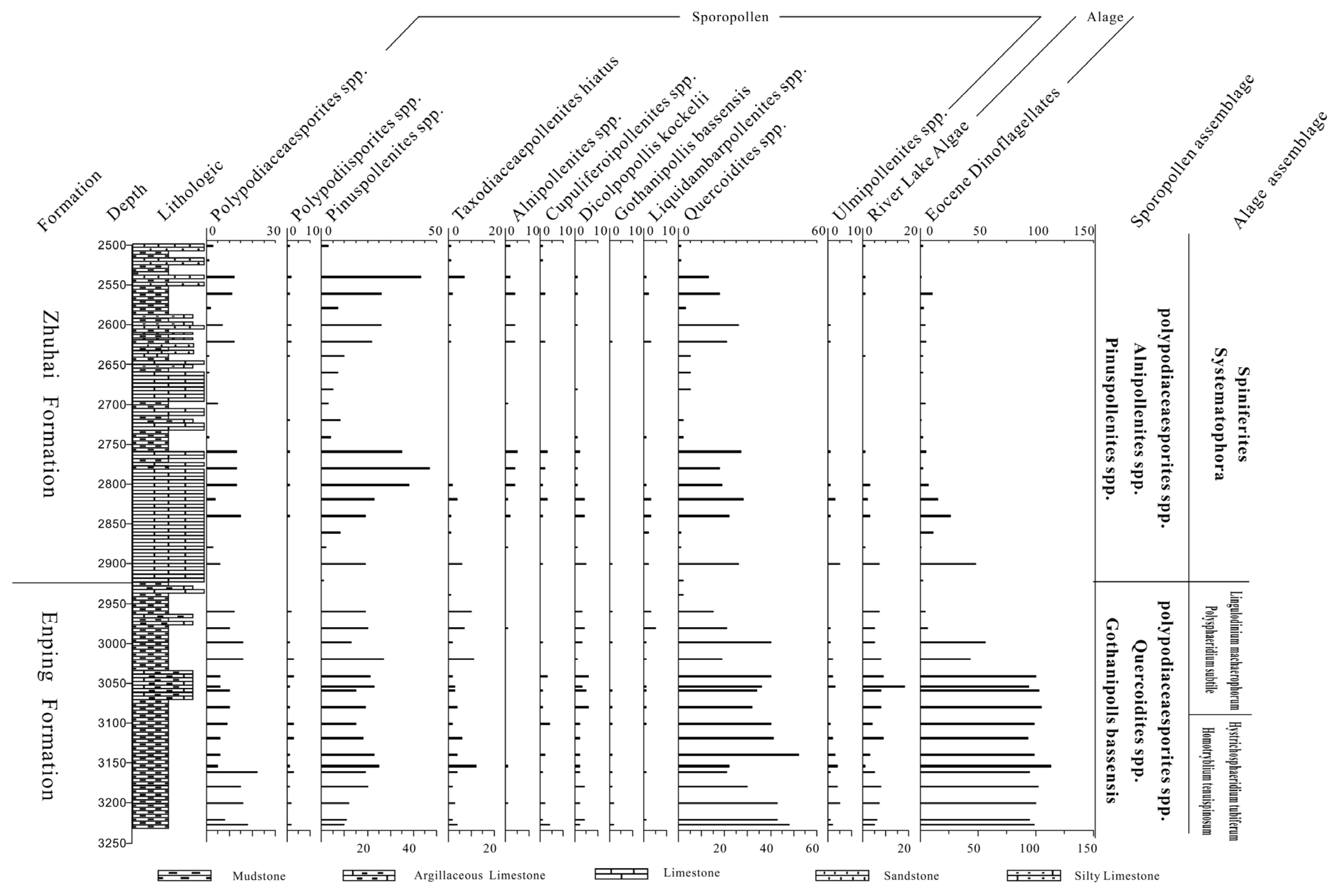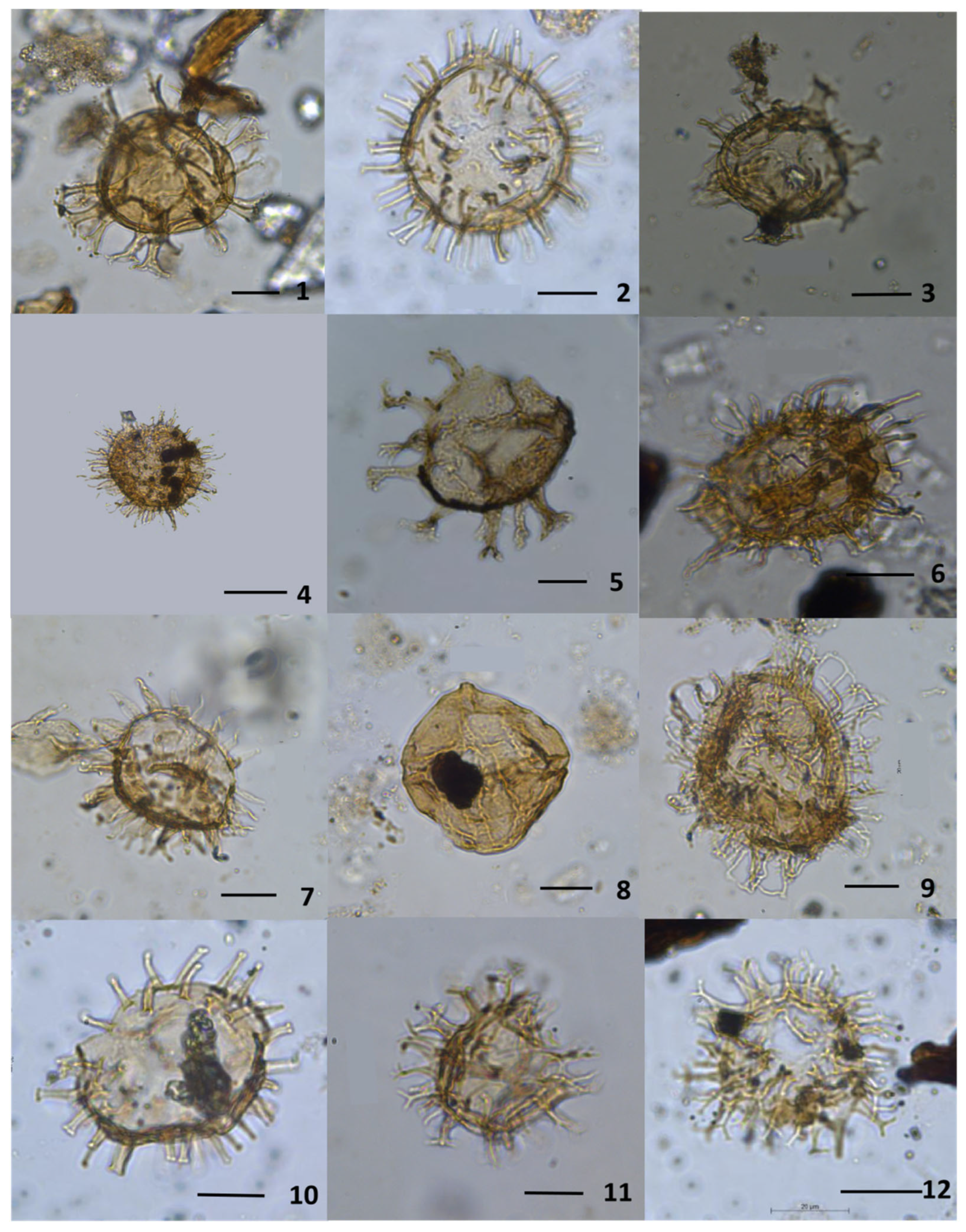Paleoclimate and Paleovegetation Significance of Paleogene Sporopollen–Algae Assemblage in the Eastern Portion of the South China Sea
Abstract
1. Introduction
2. Materials and Methods
3. Results
3.1. Sporopollen Assemblages
3.2. Algal Assemblages
4. Discussion
4.1. Comparison of the Findings from Well DW-2 with Other Regional Geological Records
- (1)
- Enping Formation
- (2)
- Zhuhai Formation
4.2. Paleoclimate and Paleovegetation Significance of the Paleogene Sporopollen–Algae Assemblage from the Well DW-2
5. Conclusions
- The research focuses on stratigraphic significance and environmental implications. Two distinct spore/pollen assemblages and three algal assemblages were identified, aligning closely with the regionally established fossil types of the Enping and Zhuhai Formations.
- The transitions observed in spore/pollen characteristics reflect a shift from tropical and subtropical assemblages to subtropical and temperate ones, indicative of the warm and humid climate during the formation of the Enping Formation and the relatively cooler and drier conditions during the formation of the Zhuhai Formation.
- The algal data suggest that the Enping Formation was deposited in a shallow marine setting, whereas the Zhuhai Formation was primarily formed in a transitional marine/terrestrial environment along the shelf margin. These findings can be further supported by the regional lithologic evidence,
- These findings offer insights into the stratigraphy, paleoenvironment, and biological diversity of the region, and a pathway for assessing the oil and gas resource potential in the South China Sea.
Author Contributions
Funding
Data Availability Statement
Conflicts of Interest
References
- Yin, J. Hydro-meteorological Characteristics of Oil and Gas Fields in the Western Sea Area of South China Sea and Their Influence on the Berthing Operations of Offshore Oil Supporting Vessels. Pearl River Water Transp. 2024, 15, 135–137. [Google Scholar]
- Pan, J. Distribution Characteristics, Genesis Mechanism of Fe Dolomite in the Tertiary Reservoir of Baiyun Depression and Its Relationship with CO2 Activity; Northwest University: Kirkland, WA, USA, 2018. [Google Scholar]
- Zhang, G.; Yang, H.; Chen, Y.; Ji, M.; Wang, K.; Yang, D.; Han, Y.; Sun, Y. Baiyun depression—A huge gas-rich depression in the deep water of the Pearl River Estuary Basin. Nat. Gas Ind. 2014, 34, 11–25. [Google Scholar]
- Zhao, Y.; Yang, X.; Zhu, H.; Chen, Y.; Zeng, Z.; Han, Y. Differences in sedimentary background of the Paleocene Enping Formation in Baiyun Depression and its hydrocarbon characteristics. Geosci. Technol. Intell. 2017, 36, 156–163. [Google Scholar]
- Zhao, F.; Zhu, Y.; Ji, X.; Feng, Z. Late Oligocene—Early Miocene sporulation assemblage from LW5 well in the deep-water area of the Pearl River Mouth Basin, northern South China Sea. J. Microsomal Palaeontol. 2017, 34, 201–210. [Google Scholar]
- Ye, D.; Zhong, X.; Yao, Y. Tertiary in Petroliferous Regions of China (I) Introduction; The Petroleum Industry Press: Beijing, China, 1993; pp. 56–69. [Google Scholar]
- Qin, J.; Wu, G.; Li, J. Spores, pollen, freshwater algae and dinoflagellate cysts recorded in the Oligocene-Pliocene from the southeast Hainan Basin, South China Sea. J. Microsomal Palaeontol. 2016, 33, 335–349. [Google Scholar]
- Lei, Z. Discussion on the sequence of Tertiary sporulation assemblages and related problems in the Pearl River Mouth Basin. In Tertiary Microsomal Palaeontology and Oceanography of the Pearl River Mouth Basin, South China Sea; Hao, Y., Xu, Y., Xu, S., Eds.; China University of Geosciences Press: Wuhan, China, 1996; pp. 32–42. [Google Scholar]
- Li, S.; Xie, J.; Liu, X.; He, W.; Zhu, Y. Biostratigraphic research on the Paleogene-Neogane boundary in the western Pearl River Mouth Basin. Acta Micropalaeontol. Sin. 2010, 27, 221–230. [Google Scholar]
- Zhang, Y.; Liu, D.; Zhang, X. Neogene palynological assemblages from Qiongdongnan Basin and their paleoclimatic implication. Marone Geol. Quat. Geol. 2017, 37, 93–101. [Google Scholar]
- Mao, S.; Lei, Z. Tertiary dinoflagellates and paleoenvironmental evolution of Pearl River Mouth Basin. In Research on Micropalaeontology and Paleoceanography in the Pearl River Mouth Basin, South China Sea; China University of Geology Press: Wuhan, China, 1996; pp. 52–66. [Google Scholar]
- Ma, X. Tertiary Dinoflagellate Cysts from the Well PY33–1-1 in Pearl River Mouth Basin; China University of Geology Press: Wuhan, China, 1996; pp. 52–66. [Google Scholar]
- Zhu, Y.; Qin, J. Oligocene Dinoflagellate in the Yabei Sag, Qiongdongnan Basin, Northern South China Sea. Microsomal Palaeontol. 2021, 38, 84–92. [Google Scholar]
- Xu, J.; Pan, Z.; Yang, Y.; Zhu, Y.; Fan, N. The Paleogene Microphytoplankton from the Shengli Oil-Bearing Region, Shandong; China University of Petroleum Press: Dongying, China, 1997; pp. 1–241. [Google Scholar]
- He, C. Late Cretaceous to Early Tertiary Dinoflagellates and Other Algae from the Western Tarim Basin, Xinjiang; Science Press: Beijing, China, 1991. [Google Scholar]




| Strata | Lei Zuoqi, 1996 [8] | Zhao Fei, 2017 [5] | Qin Jungan, 2016 [7] Zhang Yifan, 2017 [10] | This Study |
|---|---|---|---|---|
| Zhuhai Fm. | Pinuspollenites– Alnipollenites | Pinuspollenites– Alnipollenites | Polypodiisporites– Quercia evergreen– Quercia decidouous | Pinuspollenites– Alnipollenites– Polypodiaceaesporites |
| Enping Fm. | Gothanipollisbassensis Stover– Dicolpopollis kockelii | Quercoidites- Dicolpopollis kockelii– Polypodiisporites | Gothanipollis Bassensis Stover– Quercoidites– Polypodiaceaesporites |
| Strata | Mao Shaozhi, 1996 [11] | Ma Xinxiang, 1996 [12] | This Study | |
|---|---|---|---|---|
| Zhujiang Fm. | Polysphoeridium subtile– Lingulodinium machaerophorum | Homotryblium tenuispinosum– Systematophora ancyrea | ||
| Zhuhai Fm. | Homotryblium plectilum– Cordosphaeridium gracile | Systematophora–Spiniferites | ||
| Homotryblium Abbreviatum– Cordosphaeridium gracile | ||||
| Enping Fm. | Homotryblium tenuispinosum– Hystrichosphaeridium tubiferum | Polysphaeridium subtile– Lingulodinium machaerophorum | ||
| Homotryblium tenuispinosum– Hystrichosphaeridium tubiferum |
Disclaimer/Publisher’s Note: The statements, opinions and data contained in all publications are solely those of the individual author(s) and contributor(s) and not of MDPI and/or the editor(s). MDPI and/or the editor(s) disclaim responsibility for any injury to people or property resulting from any ideas, methods, instructions or products referred to in the content. |
© 2025 by the authors. Licensee MDPI, Basel, Switzerland. This article is an open access article distributed under the terms and conditions of the Creative Commons Attribution (CC BY) license (https://creativecommons.org/licenses/by/4.0/).
Share and Cite
Qiu, K.; Zhao, Z.; Wei, W.; Cao, J.; Yu, Y.; Yang, J. Paleoclimate and Paleovegetation Significance of Paleogene Sporopollen–Algae Assemblage in the Eastern Portion of the South China Sea. Water 2025, 17, 1570. https://doi.org/10.3390/w17111570
Qiu K, Zhao Z, Wei W, Cao J, Yu Y, Yang J. Paleoclimate and Paleovegetation Significance of Paleogene Sporopollen–Algae Assemblage in the Eastern Portion of the South China Sea. Water. 2025; 17(11):1570. https://doi.org/10.3390/w17111570
Chicago/Turabian StyleQiu, Kunqi, Zhichao Zhao, Wenyan Wei, Jie Cao, Yongzhao Yu, and Jilei Yang. 2025. "Paleoclimate and Paleovegetation Significance of Paleogene Sporopollen–Algae Assemblage in the Eastern Portion of the South China Sea" Water 17, no. 11: 1570. https://doi.org/10.3390/w17111570
APA StyleQiu, K., Zhao, Z., Wei, W., Cao, J., Yu, Y., & Yang, J. (2025). Paleoclimate and Paleovegetation Significance of Paleogene Sporopollen–Algae Assemblage in the Eastern Portion of the South China Sea. Water, 17(11), 1570. https://doi.org/10.3390/w17111570





